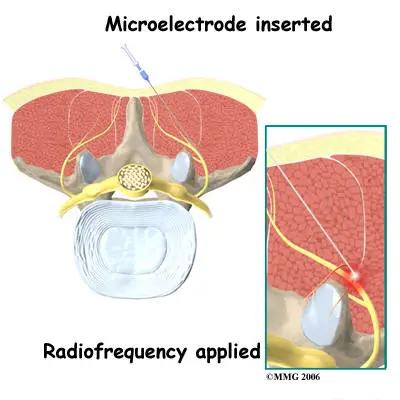Facet Joint Radiofrequency (Rf)
Take the first step toward relief. Complete the form, and we’ll reach out to you for a confidential discussion about your needs.
Overview
A patient with primary facet pain, proven with either one or more blocks, may be a candidate for a facet rhizotomy using radiofrequency (RF). The patients selected for rhizotomy are those who are not surgical candidates and who have failed other conservative measure.
By using the radiofrequency rhizotomy, the surgeon denervates the medial branch nerve which runs along the posterior spine near the facet joints.
Radiofrequency ablation or lesioning is a term used when radio waves are used to produce heat to destroy tissue, usually a nerve. It has been used for several years with great success in patients who have abnormally fast heartbeats. More recently, it is being used to destroy tumors. It is also a non-surgical option to treat your spine pain.
Spine pain is the second most frequent pain complaint. It occurs in 65 to 80 percent of the population at one time or another, and can be disabling and frightening. Its costs to society are great.
In the case of spinal pain, radiofrequency waves are transmitted through a needle placed into the facet joint under x-ray guidance. This procedure is also known as rhizotomy.

Radiofrequency (RF)
For chronic cases of facet joint syndrome, where the pain relief from the injections is short lived a procedure called Radiofrequency Rhizotomy or facet neurotomy or simply RF can be performed. There are nerves that arise from the facet joints that carry the painful impulses to the brain. Heating these nerves by radiofrequency waves can block this transmission.
What is RF?
Facet neurotomy is a procedure which results in interruption of the nerve supply to a facet joint. A radio-frequency probe that heats the 2 small nerve branches to each facet joint accomplishes this interruption known as denervation. These nerves are called the medial branches.
How is RF done?
With the patient in a prone position [laying on your stomach] and under local anesthesia and fluoroscopic guidance, a radio-frequency needle is advanced to the base of the transverse processes. The needle is placed along the course of the medial branch. The needle is heated to 80° C for 90 seconds. At least 2 branches for each joint are treated in this same manner. Sometimes a cold radio frequency is done, especially for cervical facets, which does not involve heating, but does involve a special pulsed radio wave. Frequently, a small does of IV anesthesia medication is given for sedation. However, this medication is not intended to make you unconscious. You must be awake and responsive during the procedure.
How long does RF take?
The neurotomy takes 10 to 45 minutes, depending on the number of levels to be done. The patient is then recovered in the observation area for 30 minutes to 1 hour.

Experience Relief With Facet Joint Radiofrequency
Don’t let pain control your life. Contact us today to schedule your consultation and take the first step towards a pain-free future.
What will happen after the procedure?
Immediately after the procedure, you will get up and walk and try to imitate something that would normally bring about your usual pain. You will then report the percentage of pain relief and record the relief you experience during the next week. You should not drive the day of the procedure. Your legs may feel weak or numb for a few hours.
General Pre/Post Instructions
- You should eat a light meal within a few hours before your procedure. If you are an insulin dependent diabetic, do not change your normal eating pattern prior to the procedure. Please take your routine medications (i.e. high blood pressure and diabetic medications).
- Do not take pain medications or anti-inflammatory medications the day the day of your procedure. You need to be hurting prior to this procedure. Please do not take any medications that may give you pain relief or lessen your usual pain. These medications can be restarted after the procedure if they are needed.
- If you are on Coumadin, Heparin, Plavix or any other blood thinners (including Aspirin), or the diabetic medication Glucophage you must notify this office so the timing of these medications can be explained. You will be at the clinic for approximately 1-3 hours for your procedure.
- You will need to bring a driver with you. You may return to your normal activities the day after the procedure, including returning to work.
Risks of RF?
Increased localized back pain and/or leg pain can be expected from several days to several weeks and rarely several months. Destabilization of the facet joint is a risk and post injection training to strengthen the extensor muscles can prevent this possibility. There is a rare risk of permanent injury to nerve tissue with weakness or loss of sensation. There is also a rare risk of complication from anesthesia used to make you feel more comfortable during the procedure.
As with any procedure, there is a risk of significant complications. The most common side effects from the RF include (but are not limited to):
- Allergic reactions to medications.
- Infection (occurs in less than 1 per 15,000 injections).
- Post-injection flare (joint swelling and pain several hours after treatment, which may last days or weeks).
- Depigmentation (a whitening of the skin).
- Local fat atrophy (thinning of the skin).
- Destruction of an unexpected motor or sensory nerve in the path of the radiofrequency needle.
- Bleeding, nerve injury, organ injury and death are rare but possible.
- Neuritis with inflammation of the nerve with pain and tenderness that lasts three to six weeks. This can occur in 10 to 15 percent of patients.
- Neuroma is a tumor from a nerve made of nerve cells and fibers. It forms around the area destroyed during radiofrequency ablation and can itself cause pain.
- Numbness-nerve damage.
- Lack of pain relief even though a test block was beneficial.
Expected Outcome of RF?
Following the neurotomy, there is a 60 to 80% chance of pain relief. This typically last for 3 months to 2 years. The nerve eventually grows back and the procedure can be repeated. While the patient is experiencing pain relief vigorous physical therapy is necessary to try and strengthen the involved facet joint(s). You should expect no pain relief for the first 72 hours, with peak relief occurring 6 weeks later.
Send A Message
For questions and concerns, please fill out the form below.
Pain Conditions We Treat
At Padda Institute, our pain management specialists & pain specialist doctors provide you the guidance and treatments tailored to your needs. We are best at what we do; we diagnose and evaluate to determine your best treatment plan, so that you can experience chronic pain relief like never before.
